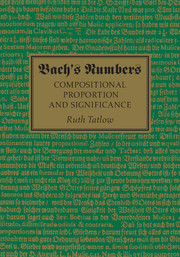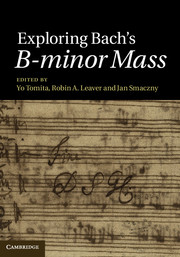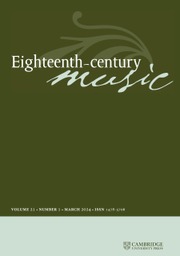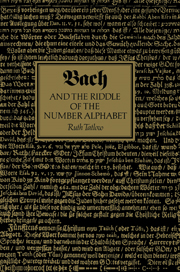Bach's Numbers
Compositional Proportion and Significance
- Author: Ruth Tatlow
- Date Published: August 2015
- availability: Available
- format: Hardback
- isbn: 9781107088603
Hardback
Other available formats:
Paperback, eBook
Looking for an inspection copy?
Please email [email protected] to enquire about an inspection copy of this book
-
In eighteenth-century Germany the universal harmony of God's creation and the perfection of its proportions still held philosophical, moral and devotional significance. Reproducing proportions close to the unity (1:1) across compositions could render them beautiful, perfect and even eternal. Using the principles of her groundbreaking theory of proportional parallelism and the latest source study research, Ruth Tatlow reveals how Bach used the number of bars to create numerical perfection across his published collections, and explains why he did so. The first part of the book illustrates the wide-ranging application of belief in the unity, showing how planning a well-proportioned structure was a normal compositional procedure in Bach's time. In the second part Tatlow presents practical demonstrations of this in Bach's works, illustrating the layers of proportion that appear within a movement, a work, between two works in a collection, across a collection and between collections.
Read more- Proposes a new theoretical basis for Bach's compositional method
- Part I provides comprehensive coverage of the evidence supporting every aspect of the theory of proportional parallelism
- Part II uses practical demonstrations to apply the new method to all of Bach's works
Awards
- Winner, 2016 Choice Outstanding Academic Title
Reviews & endorsements
'[This book] takes in all Bach's major collections and more, including the two Passions, three Oratorios and the B minor Mass. In sheer extent and richness of background, and number of works examined, Tatlow's book is a most original and impressive achievement that will need to be taken into account in future discussions of these fascinating compositions.' David Ledbetter, Early Music
See more reviews'For anyone who wishes to explore the logical pathways of Bach's genius, Tatlow's analysis gets to the heart of the aesthetic, theological and Pythagorean presuppositions underlying the Bachian concepts of 'Vollkommenheit', perfection through calculation; and 'Harmonie' … the harmony of proportion, here a mirror of divine order.' Gian Mario Benzing, translated from Corriere della Sera (La Lettura)
'… Tatlow's approach to the subject matter is unique, and the vigorousness with which her methodology is applied has uncovered numerous new and unexpected facts. Bach scholarship cannot ignore her voice.' Yo Tomita, Music and Letters
… Bach's Numbers clears the way for some promising new directions in Bach scholarship. Tatlow's work should be valued not only for what it suggests for future study, however, but for what it provides in its own right: a bold historical rendering of Bach's compositional process that forces us to view some of the composer's greatest works in a new light, and with deepened appreciation.' Robert L. Wells, Music Analysis
Customer reviews
Not yet reviewed
Be the first to review
Review was not posted due to profanity
×Product details
- Date Published: August 2015
- format: Hardback
- isbn: 9781107088603
- length: 427 pages
- dimensions: 254 x 180 x 23 mm
- weight: 1.01kg
- contains: 9 b/w illus. 119 tables
- availability: Available
Table of Contents
Part I. Foundations:
1. Bach's numbers
2. Symmetry, proportion and parallels
3. Unity, proportions and universal harmony in Bach's world
4. Bars, compositional planning and proportional parallelism
Part II. Demonstrations:
5. Three collections for strings
6. Four in two collections for keyboard
7. Two further collections for keyboard
8. Two small late collections
9. Two large late collections
10. Collections of concertos
11. Collections of organ works
12. Great passions and cantatas
13. Festive cut-and-paste projects: masses and oratorios
14. Lost blueprints
Appendix 1. Chronological index of musical doctrine.
LISTEN TO AN INTERVIEW WITH RUTH TATLOW ON BACH'S NUMBERS
Ruth Tatlow on Bach's Numbers: Compositional Proportion and Significance
Sorry, this resource is locked
Please register or sign in to request access. If you are having problems accessing these resources please email [email protected]
Register Sign in» Proceed
You are now leaving the Cambridge University Press website. Your eBook purchase and download will be completed by our partner www.ebooks.com. Please see the permission section of the www.ebooks.com catalogue page for details of the print & copy limits on our eBooks.
Continue ×Are you sure you want to delete your account?
This cannot be undone.
Thank you for your feedback which will help us improve our service.
If you requested a response, we will make sure to get back to you shortly.
×





